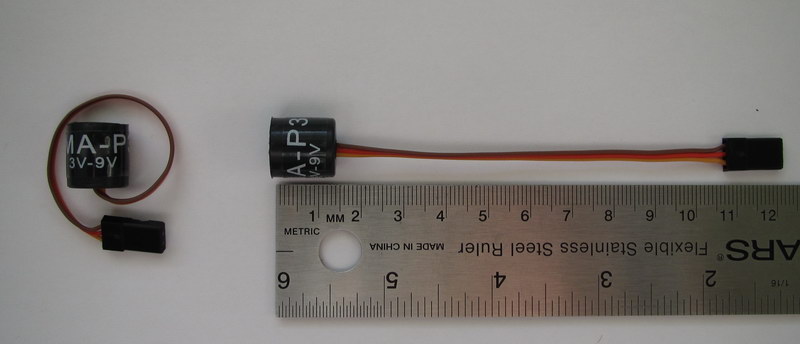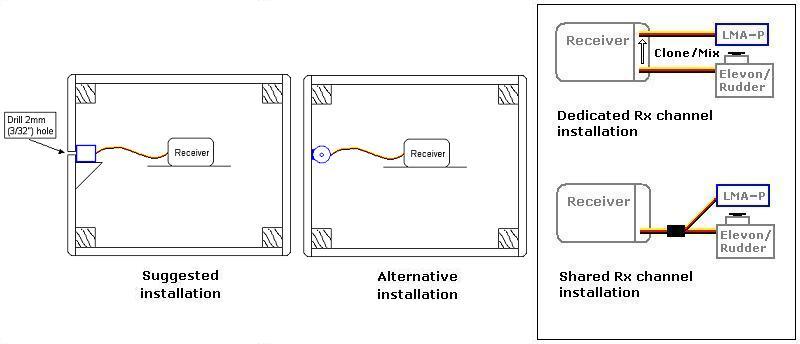
LMA-P
Description and Principle of Operation
The LMA-P lost model alarm is passively triggered, meaning the lost model alarm is activated due to inactivity on behalf of the pilot. The LMA-P model alarm is linked either directly or indirectly to an actively used channel like elevator, rudder, ailerons, and monitors the changes of commands on this channel. If there is an inactivity longer than a certain amount of time the alarm sounds. To deactivate the alarm move the radio control associated with the LMA-P lost model alarm channel; this will turn off the alarm and reset the inactivity counter. The alarm will not be triggered as long as you are changing often (within the preprogrammed inactivity timeout) the radio commands on the monitored channel. The LMA-P lost model alarm comes preprogrammed with a particular inactivity timeout value: 1, 3, 5, or 10min. On powering the LMA-P alarm the device will beep shortly the number of minutes its inactivity timeout is programmed for, e.g. one short beep for 1 minute, three short beeps for 3 minutes and so on.
The LMA-P lost model alarm is well suited for the radio controlled systems which employ the "hold position" fail-safe. In this setup even if the transmitter signal is lost and the fail-safe engaged, after activayion timeout has passed the passive lost model alarm will be triggered due to no change of servo signal on its channel.
Receivers without any fail-safe features will also trigger the alarm if no transmitter signal is present and no servo signal is passed onto the lost model alarm unit.
Set-up and Installation
If your radio transmitter functionality offers cloning or mixing of signals from one receiver channel to another, the preferred installation is to connect the LMA-P lost model alarm to a unused channel of your receiver - one that you can set in such a way that its signal is a function of a primary actively used channel, e.g. elevator, rudder, ailerons. Alternatively use a Y-Splitter servo cable to physically attach the LMA-P lost model alarm to share the output of an actively used channel, e.g. elevator, rudder, ailerons. Employing a Y-Splitter servo cable as alternative installation is also feasible if a suitable free receiver channel may not be immediately available.
The preferred and more efficient installation of the LMA-P lost model alarm in your model suggests opening a small hole (~2mm) in the model walls and attaching the LMA-P lost model alarm so its sound emitting opening is aligned with this hole. Alternatively, secure the LMA-P lost model alarm in a suitable spot inside the model, check the sound. (please refer to the installation diagrams.) Depending on your model's structure the whole LMA-P lost model alarm can be completely exposed outside of the model too...

Powering the LMA-P
The LMA-P lost model alarm can be powered with power supplies ranging from 3V up to 9V. You can pretty much use any power source that your receiver/servos set-up can handle!
Example: You can use 4-cell or 5-cells NiCd/NiMH battery packs; or 1-cell or 2-cell LiPo/LiIon packs without exceeding the maximum voltage. These are thus suitable as a direct power source for the LMA-P lost model alarm.
Technical Characteristics
|
3V - 9V |
|
Less than 1mA silent at 5V Less than 20mA emitting sound at 5V (13mA typical at 5V) |
|
Minimum 85dB (90dB typical at 5V) at 10cm; 2300Hz |
|
3.5g (including the servo wire and connector) |
|
Ø14mm x 14mm |
|
100mm |
|
Universal |
|
1 min, 3 min, 5 min, or 10 min |
Demo Video
 |
See and hear the LMA-P lost model alarm in a short demo video on YouTube. |
